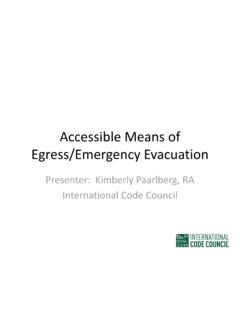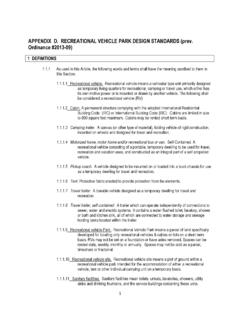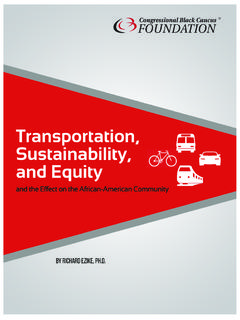Transcription of Recovery from Recent Disasters: Lessons for …
1 3/6/2018 Recovery from Recent Disasters: Lessons for Disability Planning in Remote Areas ADA National Network/FEMA Webinar Series Pacific ADA Center March 8th, 2018 Presenters: Roxann Crawford, FEMA Region IX, Disability Integration Specialist Michael Houston, FEMA Region VIII, Disability Integration Specialist Danielle Bailey, FEMA Region X, Disability Integration Specialist 1 3/6/2018 FEMA Regional Disability Integration Specialist Planning within regions Support the development of advisory groups Deployments What do we mean by Remote locations ? Territories Rural Frontier Isolated Communities 2 3/6/2018 The Geography of Disability Rates of disability are higher in rural areas: in the most rural counties compared to in urban counties People living in rural areas report onset of disability a decade earlier than urban residents Rural Americans account for only 14 % of the total US population they represent a higher share of people who live in poverty, have a disability,and are older adults.
2 Source: University of Montana Rural Institute, Research Training Center on Disability in Rural Communities. (2017) Rural Research Summary. Geographical Impacts & Disability Characteristics of the physical and built environment Service and care provider shortages Limited clinic/hospital and specialty care services Limited mental behavioral health services Culturally different perspectives/stigmas on disability Lack of public and para transit services Differences in how disability programs are administered Access to adequate housing Disability 3 3/6/2018 Virgin Islands Hurricanes Irma & Maria Virgin Islands Hurricanes Irma & Maria Hurricane Irma struck as a Category 5 major hurricane on September 5, 2017 Hurricane Maria struck as a Category 5 major hurricane on September 20, 2017 Four people died in the United States Virgin Islands At the peak of the response to both Hurricane Irma and Maria.
3 Therewere 1,400 people in nine shelters throughout the territory. 4 3/6/2018 Virgin Islands Hurricanes Irma & Maria 100% of communications and electricity were down in St. Thomas and St. John in the immediate aftermath of Hurricane Irma and partial interruption in St. Croix 100% of communications and electricity were down in St. Croix in the immediate aftermath of Hurricane Maria 531 People were medically evacuated 4,800 self evacuated on Mercy Flights and Mercy Cruises to the 38,408 total household registrations with FEMA (16,001 Irma, 22,407 Maria as of 03/01/2018) A Delicate Balance Nursing homes and assisted living facilities had waiting lists for entrypre disaster Damage to facilities and impact to service employees further impacted services available Access to Durable Medical Equipment (DME)
4 Challenging pre disasterand completely non existent post disaster External partners continue to work with survivors on DME needs Home health care services were limited and people utilized naturalsupport systems and a sense of community which was severely impacted 5 3/6/2018 Evacuation Realities Over 200 dialysis patients evacuated to the Greater Atlanta Are a Impact to systems in destination city Housing Transportation Feeding Natural support systems Mental health and emotional care Self Evacuees Support systems Transfer of services Local Groups and Successful Collaborations Local disability groups such as the UCEDD and ILC collaborated and had positive results from their work Weekly disability focused registration events Weekly Deaf focused registration events with ASL interpreters on site for each event Community outreach utilizing client list and door to door outreach to reach individuals unable to come to larger or regular disability focused registration events Working together on a weekly call to organize resources, identify gaps and shortfalls, and build capacity for forward movement AUCD working with Portlight Strategies to do research and createrecommendations for response and Recovery for the territories 6 3/6/2018 What Have We Learned From Previous Disasters Isolated Communities: 530 Landslide Source.
5 Rick Wilking CNN/AP News 7 3/6/2018 Road Map of SR530 Area & Traffic Reroute Impacts to People with Disabilities Lack of paratransit medical transport Delay in getting prescriptions Care giver/provider travel time 8 3/6/2018 Frontier Communities: Alaska Flooding Photo Source: AP Photo National Weather Service, Ed Plumb Isolated communities: Alaska Flooding Rebuilding Evacuation Rebuilding: considerations for elevation More difficult to coordinate wrap around services 9 3/6/2018 Frontier Communities: Home elevation Source: Alexandra Gutierrez/APRN Home Rebuilding in Alaska Photo by Adam DuBrowa Jul 15, 2014 Location: Circle, AK 10 3/6/2018 Isolated Communities: Colorado There were isolated communities created in the mountains when roads washed out; experiences weresimilar to Oso event (long new commutes, some 2 3 hours each way) Majority of washed out roads were private; people choose to remain in their (undamaged) Became a local/state issue (local gov t sent resources tosupport these families since their homes were not damaged and didn t qualify for FEMA assistance) Isolated Communities: Colorado (continued) FEMA sent DSA teams to these communities and needed weather balloons type solutions that provided access tothe internet which helped them connect to their iPads toregister survivors Lesson learned: back then FEMA HQ controlled Facebook; during Harvey, FEMA in TX received permission from HQ to start a Harvey Facebook page and utilized all resources available ( , Facebook Live).
6 This is helping us reach more communities 11 3/6/2018 Lessons Learned Have plans for after evacuation oContinuation of care Remember that emergency management and response people don t know what they don t know. oWorking with Ems and other organizations to educate about the needs of people with disabilities during an evacuation (DME, accessible transportation, continuation of care, natural support systems, etc.) Working with clients to address the realities of events and their preparedness shortfalls/gaps Lessons Learned (continued) Participate in drills and events oBecome familiar with your local emergency management, police, fire, CERT, etc. Work with local and state for the creative ideas of EMAC ingsocial service organizations Importance of mental health and emotional care 12 3/6/2018 You do not have to do this alone!
7 Building Local and State Partnerships Disability Core Advisory Group building Individual and agency preparedness planning Integration with local/state emergency management Seek opportunities to gain experience Don t wait to be invited (what capabilities can you bring to the table) Identify your disability networks 13 3/6/2018 National Partnerships Pass It On Center Provide coordination and support in the event of natural disasters to assurethat reutilized assistive technology can reach those who need it quickly. Provide telephone and email technical assistance through its Rapid Response Solutions Desk to various request. Establish national transportation and electronic networks for the well coordinated distribution of reutilized AT FODAC Durable Medical Equipment response to USVI Community support and creative responses to getting DME out to people who need it National Partnerships Portlight Focus on disaster response and relief Directly uses funds to support local organizations to be able to restore or expand their functions Ability to send staff and financial support to shore up operations (not lead or take over but support to allow impacted employees and organizations time to recover)
8 Provides support to other national level organizations to enhance their functions and effectiveness 14 3/6/2018 National Partnerships Partnership for Inclusive Disaster Strategies Focused on convening, collaborating, and supporting through technical assistance, problem solving and community engagement Created the national hotline for disaster response and immediate needs Able to respond to high level time sensitive requests (ex: partnership with the Cajun Navy) and individual needs (ex: getting specific consumable medical supplies to an individual during the peak of response in a two hour time frame) National Partnerships National Council on Independent Living (NCIL) : Emergency Preparedness Subcommittee Working with Agency on Community Living & Independent Living Administration on policy for Independent Living Centers involvementin emergency planning, response, and Recovery .
9 MOUs with ARC, FEMA, Portlight, PIDS and in negations with others Documenting disaster outcomes and after action on impacts to people with disabilities and others with access and functional needs Maintain dialog with DHS Office of Civil Rights and Civil Liberties in regards to disability rights 15 3/6/2018 Strengths of Rural, Frontier and Territory Communities Strong relationships between people and organizations Willingness to volunteer Natural support systems Resilient communities (history of preparedness based on environment) What Can We Do Additional training and awareness: increase preparedness Improve reach of services through disability organizations /agencies Sharing experiences and Lessons learned Expand partnerships think coordinated and consolidated efforts Identify shortfalls and gaps and clearly community with Emergency Management 16 3/6/2018 Information and Resources Association of Programs for Rural Independent Living (APRIL) Research and Training Center on Disability in Rural Communities atUniversity of Montana National Institute on Disability, Independent Living and Rehabilitating Research National Agrability Project USDA sponsored program that assistsfarmers and ranchers and other agriculture workers with disabilities Rural Health Information HUB (Online Library) Resources.
10 ADA National Centers Pacific ADA Center (Region 9) preparedness publications resources Rocky Mountain ADA Center (Region 8) Northwest ADA Center (Region 10) 17 3/6/2018 Links to Information and Resources Thank You Region 9 Region 8 Region 10 18





